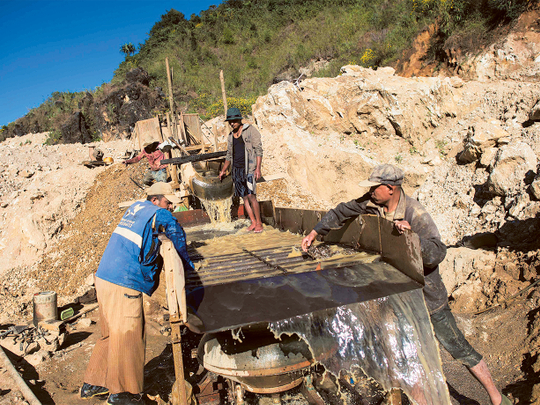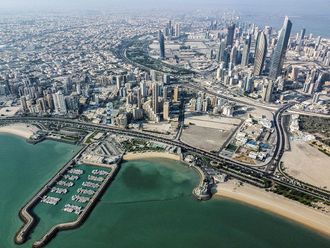
Mogok, Myanmar: Every week Aye Min Htun prays he will find the ruby that changes his life, one of thousands of people scratching a living in Myanmar’s mines set to gain little from the end of US sanctions on the military-dominated industry.
For centuries emperors, kings and warlords have vied for control over the valley of Mogok, north of Mandalay, once known as the “land of rubies” for its extraordinary treasure trove of jewels.
Its unique “pigeon-blood” stones are the most expensive coloured gems in the world — last year the so-called Sunrise Ruby sold for a record $30.3 million, over $1 million a carat.
Myanmar produces more than 80 per cent of the world’s rubies, yet decades of isolation under the former military junta means the industry remains cloaked in mystery.
But the focus on it is sharpening.
In October, the US lifted sanctions barring imports of the rubies in recognition of the country’s shift towards democracy under the new government of Aung San Suu Kyi.
Experts fear any boom will end up lining the pockets of military men and their friends who control much of the gem trade.
Aye Min Htun earns less than $200 a month working in a small, open-cast mine on the valley floor, but if he found a valuable ruby his commission could set him up for life.
“My dream is to set up a business if I am successful in mining,” the 19-year-old told AFP on a rare recent visit by journalists to Mogok’s mines.
“I believe in spirits ... I pray they will give me a big, good-quality stone.”
Behind him a dozen men use high-pressure hoses to dislodge earth from the side of the crater, which is then sorted on wooden tables by barefoot workers.
It is dangerous work — landslides are a frequent hazard.
“I’m always reminding the mine workers to be careful ... They are just kids,” said manager Pauksi, who goes by one name.
Every few minutes deep rumbles rise from the belly of the earth.
They come from dynamite detonated in the next mine, blasting shafts hundreds of feet into the hillside.
Production in Mogok has surged since the mid-90s when the former junta first allowed in private companies, bringing with them heavy machinery and more intensive mining methods.
In 2003 the US imposed its first round of sanctions barring imports of gems from Myanmar in a bid to starve the military government of funds.
Today the Mogok valley is pockmarked with mines, but locals see little of the profits.
The industry is overseen by the Myanmar Gems Enterprise (MGE), a state-owned enterprise run by former military men that was taken off the US sanctions list in May.
MGE both holds investments in mines and regulates them, giving it a strong hand over a lucrative sector.
But experts believe much of the real power lies with the Myanmar Economic Corporation (MEC), a sprawling military holding company until recently also blacklisted by Washington.
A study by the Extractive Industries Transparency Initiative reported the MEC has joint-ventures in almost 100 mines in Mogok and another ruby region in Shan state.
Another resources watchdog, the NRGI, says “military-affiliated companies such as MEC actually dominate the gems market” and are instrumental in allowing “access by private companies”.
MGE did not reply to repeated requests for comment and the MEC could not be reached.
Many private companies in Mogok are also believed to be operated by Thais and Chinese, who use shell companies to bypass laws barring any foreigners from running Myanmar’s mines.
The highest-quality stones are smuggled across the country’s porous eastern borders to Bangkok or Hong Kong, where they are polished and made into jewellery.
“Red (rubies) and blue (sapphires) mostly went to the black market in Thailand,” said Tun Hla Aung, from industry body the Myanmar Gems & Jewellery Entrepreneurs Association.
In the tourist hub of Mandalay, dealers are hopeful the end of US sanctions will bring a surge in American visitors looking to buy their wares.
“The (ruby) price will go up in the next three or six months,” Khine Khine Oo speculated at her stall in the city’s gems market, where customers sift through small piles of unpolished stones on trestle tables.
“We estimate about a 50 per cent increase ... [or] at least a third,” she said grinning, adding that dealers were stockpiling the best rubies.
For their part, US companies are already sniffing around.
Weeks after the end of sanctions were announced, the American Gem Trade Association sent a delegation to visit Mogok and hold talks with the industry.
“US dealers will be returning to do business,” said chief executive Douglas Hucker.
All will “work with licensed dealers” and “seek to determine that the gemstones they are buying are sourced responsibly,” he said, without giving further details of how.
In a bid to put the brakes on unfettered exploitation of Myanmar’s jade and gemstones, the government imposed a moratorium in July on new mining licenses.
Companies must now meet stricter environmental regulations to get permits — but exactly how they are allocated is unclear.
Ko Ko Aung, office manager of Myanmar San Taw Win Gems which has around 10 plots in Mogok, said “most mines are losing money right now” as large-scale excavation has been stopped.
But according to Michael Gibb of advocacy group Global Witness, US buyers must follow stricter international rules to make sure the mines enforce decent working conditions and environmental standards.
They must also ensure profits do not fuel Myanmar’s myriad borderland conflicts.
“The onus is on American companies to investigate the risks ... knowing that in a country like Myanmar, there obviously are risks,” he said.












